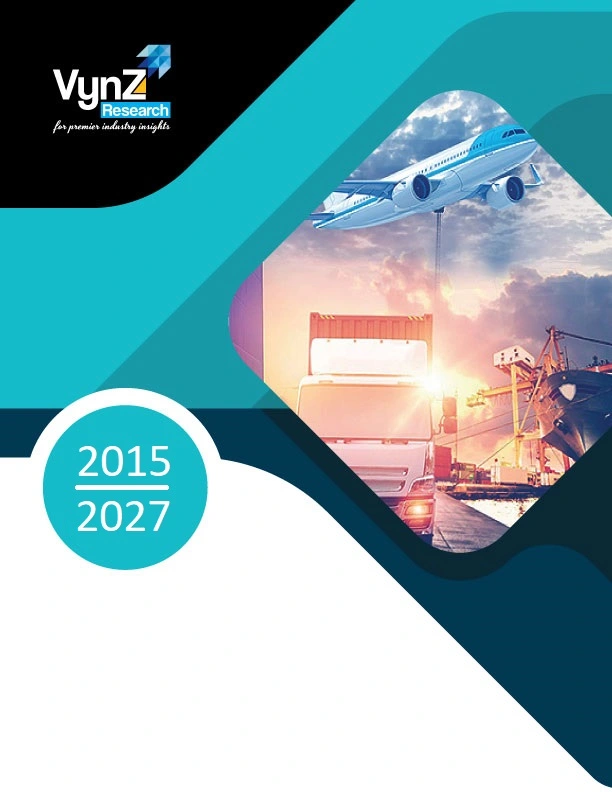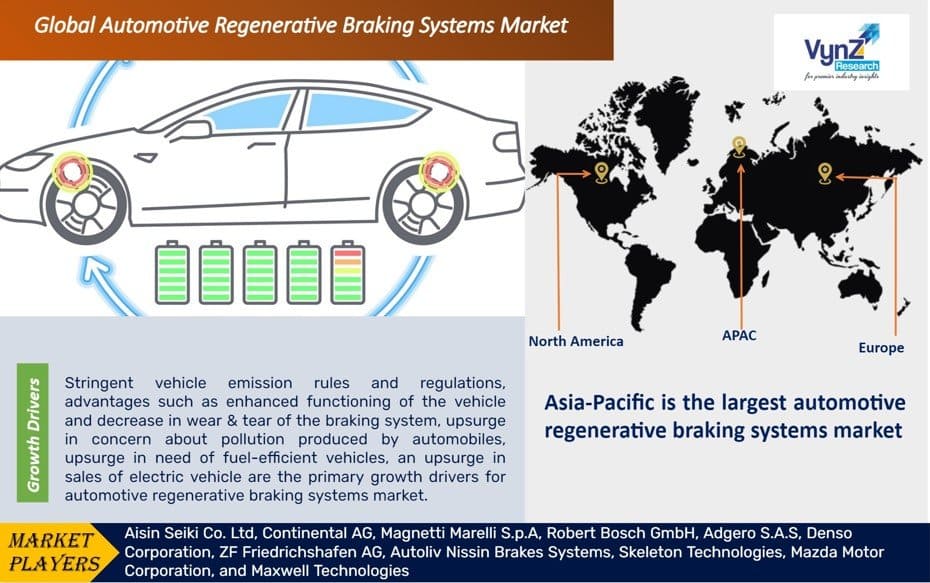| Status : Upcoming | Report Code : VRAT4021 | Industry : Automotive & Transportation | Available Format :

|

Global Automotive Regenerative Braking Systems Market – Analysis and Forecast (2025-2030)
Industry Insights by Storage Type (Batteries, Flywheels, Ultracapacitors, and Hydraulics), and by Vehicle Type (Passenger Car, and Commercial Vehicles) and By Geography (North America, Europe, Asia-Pacific and Japan and Rest of the World)
Industry Overview
Automotive Regenerative Braking Systems is an energy retrieval mechanism that alters the heat formed from friction in brakes into electrical energy. It upsurges the fuel proficiency of the vehicle and declines the greenhouse gas emissions by the vehicle. Moreover, it recuperates the vehicle's kinetic energy which is usually misused during deceleration. The recuperated energy is deposited in discrete types of energy storage units such as batteries, flywheels, ultracapacitors, and others. The global automotive regenerative braking systems market is growing at a significant rate, due to stringent vehicle emission rules and regulations, and an upsurge in a number of electric vehicles.

Different vehicle types such as passenger cars and commercial vehicles contributed to the automotive regenerative braking systems market size. The market has witnessed high demand for the passenger car segment in automotive regenerative braking systems due to the mounting number of electric cars in countries such as China, and an upsurge in the deployment of regenerative braking systems in passenger cars.
Automotive Regenerative Braking Systems Market Segmentation
Insight by Storage Type
On the basis of storage type, the automotive regenerative braking systems market is subdivided into batteries, flywheels, ultracapacitors, and hydraulics. Of all storage types, batteries segment accounted the largest share in the market. In addition, ultracapacitors segment is expected to grow at fastest rate in the market due to its advantages such as high storage capacity, the capability to surge high amount of power, and greater efficiency, and improved performance competencies.
Insight by Vehicle Type
On the basis of vehicle type the market is subdivided into a passenger car, and commercial vehicles. Among the all vehicle type, the passenger car accounted the larger share and is expected to grow at faster rate in the automotive regenerative braking systems market due to the mounting numeral of electric passenger cars in countries such as China, and an upsurge in the deployment of regenerative braking systems in the passenger cars.
Global Automotive Regenerative Braking Systems Market Report Coverage
|
Report Metric |
Details |
|
Historical Period |
2018 - 2023 |
|
Base Year Considered |
2024 |
|
Forecast Period |
2025 - 2030 |
|
Market Size in 2024 |
U.S.D. XX Billion |
|
Revenue Forecast in 2030 |
U.S.D. XXXX Billion |
|
Growth Rate |
XX% |
|
Segments Covered in the Report |
By Storage Type, and By Vehicle Type |
|
Report Scope |
Market Trends, Drivers, and Restraints; Revenue Estimation and Forecast; Segmentation Analysis; Impact of COVID-19; Companies’ Strategic Developments; Market Share Analysis of Key Players; Company Profiling |
|
Regions Covered in the Report |
North America, Europe, Asia-Pacific and Japan and Rest of the World |
Industry Dynamics
Automotive Regenerative Braking Systems Market Growth Drivers
Stringent vehicle emission rules and regulations, advantages such as enhanced functioning of the vehicle and decrease in wear & tear of the braking system, upsurge in concern about pollution produced by automobiles, upsurge in need of fuel-efficient vehicles, an upsurge in sales of electric vehicle are the primary growth drivers for automotive regenerative braking systems market. For instance, according to the World Health Organization (WHO), globally exposure to ambient air pollution leads to 4.2 million deaths every year. In addition, 91% of the world’s population lives in a place where air quality exceeds WHO guidelines limits.
Technological advancement in two-wheelers, the upsurge in several electric vehicle supply equipment and electric vehicles, the surge in the number of vehicles on the road, and the acceptance of regenerative braking systems in locomotives are also facilitating the growth of the automotive regenerative braking systems market.
The surge in the number of vehicles on the road is directly affecting the greenhouse gases which are severely affecting the atmosphere. Thus, governmental bodies throughout the globe are tapping attempts to control pollution by restrictive greenhouse gas emissions by vehicles. Moreover, the governing bodies are also stipulating tax benefits and subsidies to the manufacturers who abide by the rules. Thus, these stringent rules and associated tax benefits encouraged the manufacturers to install regenerative braking system to control greenhouse gases emissions.
Automotive Regenerative Braking Systems Market Challenges
Elevated repair and maintenance cost, and an upsurge in overall price and weight of the vehicle are the major challenges for the growth of automotive regenerative braking systems market.
Automotive Regenerative Braking Systems Industry Ecosystem
Globally industry players are leveraging market growth through launching new products. Moreover, the high level of capital requirement also poses a major barrier to the entry of new players. This offers an edge to the established players in the industry competition.
Automotive Regenerative Braking Systems Market Geographic Overview
Geographically, Asia-Pacific is the largest automotive regenerative braking systems market and is observed to witness the fastest growth in the market due to the larger number of vehicles installed with regenerative braking systems. In addition, stringent vehicle emission rules and regulations, and an upsurge in need of fuel-efficient vehicles are also up surging growth of the Asia-Pacific automotive regenerative braking systems market.
Automotive Regenerative Braking Systems Market Competitive Insight
Key players in the automotive regenerative braking systems market are catering for the demand by collaborating with small players and investing in technologically advanced products across the globe.
Aisin Corporation is a Japanese corporation that produces and develops components and systems for the automotive industry.
Continental AG is a German multinational automotive parts manufacturing company that specializes in powertrain, brake systems vehicle electronics, tyres, automotive safety, chassis components, tachographs and other parts for the automotive and transportation purpose.
Aisin Seiki Co. Ltd, Continental AG, Magnetti Marelli S.p.A, Robert Bosch GmbH, Adgero S.A.S, Denso Corporation, ZF Friedrichshafen AG, Autoliv Nissin Brakes Systems, Skeleton Technologies, Mazda Motor Corporation, and Maxwell Technologies are the key players offering automotive regenerative braking systems.
Recent Developments by Key Players
ASK Automotive (Auto parts maker) partnered with AISIN Group Companies (Japanese auto components supplier) in the passenger vehicle space. As part of the collaboration, the two partners will market and sell the auto components.
ZF opens location in Oragadam, India, for the production of electrical components for the Indian and Asian markets. ZF's Commercial Vehicle Solutions (CVS) division is leveraging global growth opportunities brought by increasing trends towards decarbonizing commercial vehicles.
Frequently Asked Questions
Purchase Options
Latest Report
Research Methodology
- Desk Research / Pilot Interviews
- Build Market Size Model
- Research and Analysis
- Final Deliverabvle
Connect With Our Sales Team
- Toll-Free: 1 888 253 3960
- Phone: +91 9960 288 381
- Email: enquiry@vynzresearch.com
Automotive Regenerative Braking Systems Market
